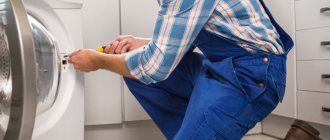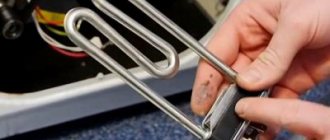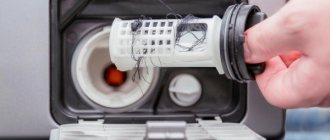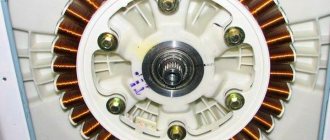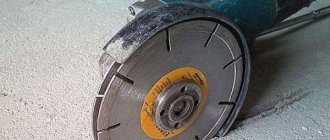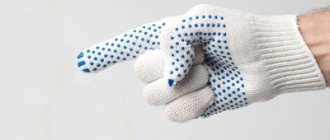The washing process in a washing machine can only be started if the door of the machine is locked until the end of the operating cycle - this is due to the requirements for the safe operation of the device - to create a perfect seal so that water does not leak out of the tank. Sometimes the machine may simply stop blocking, and until the problem is fixed, it will be impossible to start washing.
First of all, you need to check if anything is caught in the loading hatch door. If there are no obstacles to closing the door, there may be several reasons for this malfunction . Conventionally, they can be divided into two types - mechanical damage and problems with electronics. If you need your washing machine repaired, contact our company.
If the damage is mechanical, then the door will not lock at all and a characteristic click will not be heard. If there are problems with the electronics, then the door may close, but the locking will not occur - a repeated click will not be heard, indicating that the hatch is locked electronically. In the latter situation, the machine should display the corresponding error number on the display.
Mechanical damage
Mechanical damage to the hatch door can be caused by careless handling or natural wear and tear. This happens when heavy wet things are hung on the hatch door, leaned on, or slammed hard.
– breakage of the hatch door handle
In some cases, the machine may not lock due to damage to the washing machine hatch door handle. This may occur due to improper use. To eliminate the problem, the handle must be replaced.
The hatch handle is replaced with the washing machine door removed.
To do this, dismantle the front clamp - a crimp ring that tightens the rubber cuff of the hatch. After this, the cuff must be bent and, using a wrench, the nuts securing the bolts intended for fixing the hinge must be secured. This will allow you to unscrew the bolts that connect the hinge to the body of the washing machine and remove the hatch along with the hinge. If necessary, at this stage you can completely replace the hatch door of the washing machine by repeating the above steps in reverse order, but using a new, working hatch.
The removed door should be installed with the glass facing up on a flat surface so that there is access to the fastening screws connecting the halves of the plastic case. All screws are unscrewed along the perimeter of the door and the halves are disconnected. Next, you need to remove the glass and lay the inner part of the rim on a flat surface - this way you can gain access to the fastening of the machine handle. The handle is connected to the body using a pin inserted into the holes in the handle and body of the washing machine.
To dismantle the handle, move the pin to the side and disconnect the handle, mounting spring and tongue in turn. The handle is usually supplied with consumable parts - a tongue, a pin and a spring. When installing a new handle, start with the spring, then install the tongue. When installing parts, care must be taken to ensure that the holes of the parts and the housing are aligned. After this, the pin is inserted and the handle is installed.
– skewed locking tongue or hinges on the door
If the door cannot be closed completely , and something prevents it from closing completely, most likely the main functional elements of the door - the hinges or the locking tab - have shifted or failed.
To eliminate the malfunction, check the level of the door and the tightness of the fixing elements of the hatch. If there is a visible distortion, the door must be adjusted or damaged hinges replaced.
Replacing the washing machine hatch door hinge is easy to do with your own hands. First of all, you should disconnect the door and hinge from the machine body.
To replace, the hinge must be separated from the door. Washing machines of different brands have different types of hinge fastenings. Some manufacturers (Ariston, Indesit) fix the hinges in such a way that they can be dismantled without removing the door. To do this, just unscrew 4 screws. In most washing machines, the doors are designed in such a way that to remove the hinge, you must disassemble the door.
To disassemble the door, unscrew the screws that connect the plastic halves with glass installed between them. With some effort, you should separate the halves from each other. You don’t need to press too hard - this could break the entire door; you need to press in different places in a circle. After the plastic halves of the doors are disconnected, you can replace the old hinge with a new one by installing it in the same location. After installing the hinge, the plastic halves of the door must be pressed firmly against each other until a click appears. To install the door, perform the above steps in reverse order.
If the door is locked correctly, then the fault lies in the locking tab . This happens if the tongue does not fit into the lock. The reason for this phenomenon may be the displacement of the metal rod designed to fix the tongue in a certain position.
To eliminate the malfunction, it is necessary to disassemble the hatch door and place the rod in its original place. If the rod is damaged, the rod must be replaced.
– deformation of the plastic guide
If the door closes normally, but without a click and the hatch cannot be locked in the closed position, it means that the plastic guide, which is used in some models of washing machines to lock the hatch door, has become deformed. It is made of a thin layer of plastic and can be erased as the washing machine is used. To eliminate the malfunction, it is necessary to replace the part by first disassembling the hatch door.
Electronics problems
If there are no problems with the hatch door of the washing machine, the reason must be sought in the machine itself.
– failure of the hatch locking device
If the door closes freely, but the hatch does not lock, the hatch locking device is probably broken.
Under normal conditions, after turning on any of the washing programs, voltage is applied to the UBL lever, and the safety interlock closes the contact of the main switch. Throughout the entire washing process, the lever blocks the machine door. At the end of the program, power is removed from the lock and the door still remains locked for a couple of minutes.
As the temperature rises, the internal resistance of the ceramic resistor increases. The effect of temperature causes the two bimetallic plates to deform, which leads to movement of the lever and closing of the contact of the master switch.
At the same time, the latch connected to the contact plate moves outward until the door is locked. It takes 5 seconds from the moment the power is turned on to complete all actions. After the power supply is disconnected, the ceramic resistor cools down for 1-2 minutes and the plates return to their original position, after which the contact opens and the lever is released. This is why the washing machine does not open immediately - in order for the resistor to cool down, you need to wait a while.
Due to natural wear and frequent changes in the network, bimetallic plates can become damaged or stop deforming. To eliminate the malfunction, it is necessary to replace the UBL.
Replacing the washing machine door lock device
To replace the UBL, in most cases it is enough to bend the front edge of the rubber cuff. It is fixed to the body of the washing machine using a metal clamp tightened with a spring. Use a flat object to find this spring and pry it off. Actions should be performed carefully so as not to damage the integrity of the cuff. Next, remove the spring from the recess and disconnect the clamp. The locking device can be seen by folding back the appropriate edge of the cuff. To dismantle the UBL, it is necessary to disconnect the contact connector and unscrew the fasteners securing the lock. These could be screws or latches. After removing the fasteners, it is necessary to disconnect the contacts from the lock and pull out the entire part. Install the new lock in the reverse order.
– debris entering the UBL
Sometimes the machine may not close because small debris has gotten into the hole in the locking device - threads, pieces of plastic, etc. A visual inspection of the hatch locking device will help diagnose the malfunction. If the reason that the hatch does not close is the penetration of a blockage, it is necessary to disassemble the UBL and remove particles from it that prevent reliable fixation of the lock.
– failure of the control module
If all of the above malfunctions are excluded and all the parts involved in locking the washing machine door are working properly, then the reason for its incorrect operation is the failure of the control module. This happens when the board does not receive the appropriate signal about the need to block the hatch. The most common reason for this phenomenon is burnt out contact tracks or software failure . Problems with the control module may be caused by power surges.
In this case, it is necessary to conduct a complete diagnosis of the control module and, depending on the result, reprogram the board, repair it or replace it. It is not recommended to manipulate the control module yourself - this is one of the most important parts of the washing machine and any incorrect action can cause even greater damage. It is advisable to entrust repairs to professionals.
Price and place of purchase
But it is necessary to approach the issue seriously, since there are various models of heating elements on sale. They differ in power and modification.
To be sure of purchasing a new part, you can take the already removed heating element with you to the store and simply buy a similar one. Or take a photo of the markings with your phone.
For Samsung washing machines, heating elements often come with the following power:
- 1.9 kW,
- 1.85 kW.
The cost of one of the popular heating element models for a Samsung washing machine, with a built-in heat sensor, TPd 180-SG-1900, will be from 500 rubles.
The heating element is not the most expensive part. There are many types of heating elements, but it is advisable to choose a model that is similar to the one being replaced. You should not buy a used heating element, even if it is called out - there is no guarantee that it will serve for a long time.
The reason for the machine door not closing tightly
Technically, the reasons for a leaky hatch closure can be divided into two types - errors in the control board and mechanical reasons.
Mechanical reasons are damage that prevents the door from locking, so you don’t hear the click of the door closing with your ear.
Problems with the electronic component - this malfunction looks a little different. You manage to close the door, you can even hear that the lock has worked, but in fact the hatch remains not closed, because there is no second click.
If the problem is electronics, then a modern device will notify you of the problem using an error code that will appear on the notification display. This is for your own safety, so that an unlocked machine does not start working and flood you and your neighbors below.
And if the hatch cannot be closed hermetically for physical reasons, then even the oldest machines, without such sophisticated safety systems as today, will still not start the washing cycle. There is no need to worry in vain - it is best to understand the causes and consequences of the fact that happened to your washing machine.
In principle, if you don’t have time to delve into technical details, then you can right now call a technician to your home to repair your washing machine
. Because Artalis Group provides you with such an opportunity.
We also have a lot of advantages:
Free visit of a specialist to your home at your address in a short time.
Diagnostics of faults costs only 500 RUB, and when you order repairs, we give it to you as a gift.
Prices in our price list start at 500 rubles.
The masters are experienced and responsible.
We provide a guarantee on all parts and labor.
Pensioners get a 10% discount on repairs.
The door of the washing machine is broken: how to remove and disassemble
The loading hatch door is a CMA part through which the laundry intended for washing is placed into the drum. At first glance, it seems that its device does not cause any difficulties, and there should be no breakdowns. But frankly, technicians at washing machine service centers are faced with the problem of door failure quite often. Often the problem lies not in manufacturing defects, but in violation of the operating conditions of the machine. In this article you will learn how to repair a washing machine door yourself.
Why else are you unable to hermetically close the washer hatch?
If mechanical reasons due to which the door does not close are not your case, then the reason may be hidden in the washing machine itself.
The door can be closed, but the hatch does not lock
Firstly, the device responsible for blocking the hatch (UBL) could fail.
The UBL needs to be replaced.
Secondly, a small object that got there from clothing could have become clogged in the UBL.
The technician disassembles the device and removes the blockage.
Thirdly, there could be a breakdown of the electronics - the electronic control module, which does not give a signal to the UBL to block the hatch.
The board needs to be reprogrammed or replaced altogether.
Preparing for work
To troubleshoot, you must:
- find out the characteristics of the SMA and, in particular, the door itself;
- clarify the basic requirements that will have to be observed during repairs;
- prepare tools;
- buy the necessary materials and spare parts (original versions);
- if the need arises, be prepared to manufacture the necessary elements yourself.
Having outlined an algorithm for your own actions, you need to think through every step so that the washing machine door becomes operational again.
Can I solve the problem myself?
If we are talking about minor breakdowns of a technical nature, and you are confident in your qualifications, then why not - fix it yourself, but if the breakdown is inside the unit itself, and you do not have the appropriate skills and equipment, then it is best to entrust the repair to a specialist. If you decide to repair your washing machine yourself, then perhaps these videos will come to your aid:
If you are a fan of professional repairs, then welcome to - here they will listen to you, give advice, accurately determine the breakdown and qualitatively repair your washing machine. Call any day - we are always in touch with you, even on weekends and holidays.
The washing process in a washing machine can only be started if the door of the machine is locked until the end of the operating cycle - this is due to the requirements for the safe operation of the device - to create a perfect seal so that water does not leak out of the tank. Sometimes the machine may simply stop blocking, and until the problem is fixed, it will be impossible to start washing.
First of all, you need to check if anything is caught in the loading hatch door. If there are no obstacles to closing the door, there may be several reasons for this malfunction . Conventionally, they can be divided into two types - mechanical damage and problems with electronics. If you need your washing machine repaired, contact our company.
If the damage is mechanical, then the door will not lock at all and a characteristic click will not be heard. If there are problems with the electronics, then the door may close, but the locking will not occur - a repeated click will not be heard, indicating that the hatch is locked electronically. In the latter situation, the machine should display the corresponding error number on the display.
Expert recommendations
Proper care will extend the life of the equipment, so after finishing washing:
- Wipe the door and its seal dry.
- Temporarily leave the hatch open and the powder container pulled out to dry the surfaces.
- Disconnect the device from the power supply, as voltage surges can cause malfunctions.
It is also necessary to regularly clean the inlet filter in the water drainage compartment. If the machine jumps during the spin cycle, place a rubber mat under it to stabilize it and reduce vibration.
Samsung washing machines are reliable assistants in the daily routine of housewives, and if used correctly, they will serve you for a long time. The equipment is equipped with all the necessary options to obtain excellent washing results. Sorting laundry, observing the dosage of detergent and choosing the right work program will extend the life of things and maintain their presentability.
Mechanical damage
Mechanical damage to the hatch door can be caused by careless handling or natural wear and tear. This happens when heavy wet things are hung on the hatch door, leaned on, or slammed hard.
– breakage of the hatch door handle
In some cases, the machine may not lock due to damage to the washing machine hatch door handle. This may occur due to improper use. To eliminate the problem, the handle must be replaced.
The hatch handle is replaced with the washing machine door removed.
To do this, dismantle the front clamp - a crimp ring that tightens the rubber cuff of the hatch. After this, the cuff must be bent and, using a wrench, the nuts securing the bolts intended for fixing the hinge must be secured. This will allow you to unscrew the bolts that connect the hinge to the body of the washing machine and remove the hatch along with the hinge. If necessary, at this stage you can completely replace the hatch door of the washing machine by repeating the above steps in reverse order, but using a new, working hatch.
The removed door should be installed with the glass facing up on a flat surface so that there is access to the fastening screws connecting the halves of the plastic case. All screws are unscrewed along the perimeter of the door and the halves are disconnected. Next, you need to remove the glass and lay the inner part of the rim on a flat surface - this way you can gain access to the fastening of the machine handle. The handle is connected to the body using a pin inserted into the holes in the handle and body of the washing machine.
To dismantle the handle, move the pin to the side and disconnect the handle, mounting spring and tongue in turn. The handle is usually supplied with consumable parts - a tongue, a pin and a spring. When installing a new handle, start with the spring, then install the tongue. When installing parts, care must be taken to ensure that the holes of the parts and the housing are aligned. After this, the pin is inserted and the handle is installed.
– skewed locking tongue or hinges on the door
If the door cannot be closed completely , and something prevents it from closing completely, most likely the main functional elements of the door - the hinges or the locking tab - have shifted or failed.
Glass damaged
If the glass on the door is cracked, then there will be no problems with diagnostics - you can immediately begin repairs. After removing the hatch from the body, we get to work. It is important to understand that operating a “broken” machine is highly discouraged: if the seal is broken, there is a high probability of leakage and electric shock.
Replacing glass is also not an option, since this option is available for single models. Therefore, the user has only two options: buy a new machine or seal the gap. The second method is cheaper, but will require some steps.
The crack is sealed according to the following instructions.
- Secure the film on the outside of the glass with tape, avoiding voids and cracks.
- Apply reinforcing tape to the inside.
- Mix resin and hardener in a ratio of 6 to 4, adding EDP glue. You should get a homogeneous mass, similar to liquid sour cream. If the composition is too thick, it is recommended to heat it in a water bath, stirring regularly.
To seal cracks in sunroof glass, it is better to use epoxy resin, as tape and sealant give short-term results.
- Fill the crack with the prepared mixture.
- Leave for a day.
- Remove the polyethylene and sand the glass.
It is not recommended to use tape and sealant instead of epoxy resin solution - they do not last as well and give short-term results. But you need to strictly observe the proportions. Otherwise, the “protection” will not last long.
Electronics problems
If there are no problems with the hatch door of the washing machine, the reason must be sought in the machine itself.
– failure of the hatch locking device
If the door closes freely, but the hatch does not lock, the hatch locking device is probably broken.
Under normal conditions, after turning on any of the washing programs, voltage is applied to the UBL lever, and the safety interlock closes the contact of the main switch. Throughout the entire washing process, the lever blocks the machine door. At the end of the program, power is removed from the lock and the door still remains locked for a couple of minutes.
As the temperature rises, the internal resistance of the ceramic resistor increases. The effect of temperature causes the two bimetallic plates to deform, which leads to movement of the lever and closing of the contact of the master switch.
At the same time, the latch connected to the contact plate moves outward until the door is locked. It takes 5 seconds from the moment the power is turned on to complete all actions. After the power supply is disconnected, the ceramic resistor cools down for 1-2 minutes and the plates return to their original position, after which the contact opens and the lever is released. This is why the washing machine does not open immediately - in order for the resistor to cool down, you need to wait a while.
Due to natural wear and frequent changes in the network, bimetallic plates can become damaged or stop deforming. To eliminate the malfunction, it is necessary to replace the UBL.
Replacing the washing machine door lock device
To replace the UBL, in most cases it is enough to bend the front edge of the rubber cuff. It is fixed to the body of the washing machine using a metal clamp tightened with a spring. Use a flat object to find this spring and pry it off. Actions should be performed carefully so as not to damage the integrity of the cuff. Next, remove the spring from the recess and disconnect the clamp. The locking device can be seen by folding back the appropriate edge of the cuff. To dismantle the UBL, it is necessary to disconnect the contact connector and unscrew the fasteners securing the lock. These could be screws or latches. After removing the fasteners, it is necessary to disconnect the contacts from the lock and pull out the entire part. Install the new lock in the reverse order.
– debris entering the UBL
Sometimes the machine may not close because small debris has gotten into the hole in the locking device - threads, pieces of plastic, etc. A visual inspection of the hatch locking device will help diagnose the malfunction. If the reason that the hatch does not close is the penetration of a blockage, it is necessary to disassemble the UBL and remove particles from it that prevent reliable fixation of the lock.
– failure of the control module
If all of the above malfunctions are excluded and all the parts involved in locking the washing machine door are working properly, then the reason for its incorrect operation is the failure of the control module. This happens when the board does not receive the appropriate signal about the need to block the hatch. The most common reason for this phenomenon is burnt out contact tracks or software failure . Problems with the control module may be caused by power surges.
In this case, it is necessary to conduct a complete diagnosis of the control module and, depending on the result, reprogram the board, repair it or replace it. It is not recommended to manipulate the control module yourself - this is one of the most important parts of the washing machine and any incorrect action can cause even greater damage. It is advisable to entrust repairs to professionals.
Cautions
When the washing machine door is locked, you may want to open it as quickly as possible. At this stage, serious damage to equipment is possible.
To avoid them, you should remember a number of prohibitions:
- If the hatch is locked, then you cannot pull or pull the handle with force. There is a risk of damage to the hatch.
- Do not try to force the door open using a crowbar, large screwdriver, or other rough tool. Such unjustified actions can lead to breakage of the hatch, damage to the cuff and deformation of the machine itself.
- If there is any doubt about the serviceability of the door mechanism, it should be addressed. The problem should not be left “for later”.
- Do not try to open the door before the water has drained from the machine.

